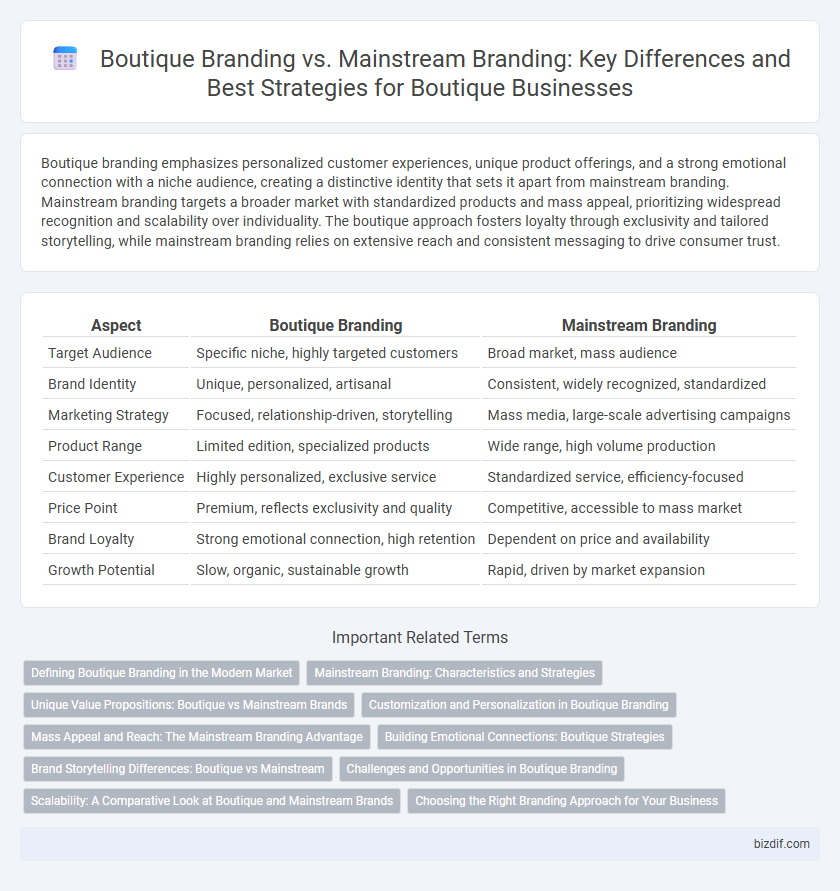Boutique branding emphasizes personalized customer experiences, unique product offerings, and a strong emotional connection with a niche audience, creating a distinctive identity that sets it apart from mainstream branding. Mainstream branding targets a broader market with standardized products and mass appeal, prioritizing widespread recognition and scalability over individuality. The boutique approach fosters loyalty through exclusivity and tailored storytelling, while mainstream branding relies on extensive reach and consistent messaging to drive consumer trust.
Table of Comparison
| Aspect | Boutique Branding | Mainstream Branding |
|---|---|---|
| Target Audience | Specific niche, highly targeted customers | Broad market, mass audience |
| Brand Identity | Unique, personalized, artisanal | Consistent, widely recognized, standardized |
| Marketing Strategy | Focused, relationship-driven, storytelling | Mass media, large-scale advertising campaigns |
| Product Range | Limited edition, specialized products | Wide range, high volume production |
| Customer Experience | Highly personalized, exclusive service | Standardized service, efficiency-focused |
| Price Point | Premium, reflects exclusivity and quality | Competitive, accessible to mass market |
| Brand Loyalty | Strong emotional connection, high retention | Dependent on price and availability |
| Growth Potential | Slow, organic, sustainable growth | Rapid, driven by market expansion |
Defining Boutique Branding in the Modern Market
Boutique branding in the modern market emphasizes personalized experiences, niche targeting, and unique brand storytelling that resonates deeply with specific consumer segments. Unlike mainstream branding, which aims for broad appeal and mass market penetration, boutique brands leverage exclusivity, craftsmanship, and authentic engagement to create strong emotional connections. This approach enhances customer loyalty and differentiates boutique brands in competitive landscapes by focusing on quality over quantity and tailored marketing strategies.
Mainstream Branding: Characteristics and Strategies
Mainstream branding emphasizes broad market appeal, utilizing mass media channels such as television, social media, and large-scale advertising campaigns to reach diverse consumer segments. It relies on consistent messaging, strong brand recognition, and competitive pricing strategies to maintain market dominance and customer loyalty. Key characteristics include standardized product offerings, extensive distribution networks, and data-driven marketing techniques to optimize engagement and sales performance.
Unique Value Propositions: Boutique vs Mainstream Brands
Boutique branding emphasizes highly personalized customer experiences and niche market appeal, offering unique value propositions that reflect exclusivity and tailored solutions. Mainstream branding targets broader audiences through mass marketing strategies, prioritizing consistency, accessibility, and widespread recognition. The distinct uniqueness of boutique brands lies in their ability to create deep emotional connections and specialized offerings, contrasting with the standardized value propositions of mainstream brands.
Customization and Personalization in Boutique Branding
Boutique branding emphasizes customization and personalization, tailoring products and services to meet the unique preferences of each client, which contrasts sharply with the one-size-fits-all approach of mainstream branding. This specialized focus allows boutique brands to build deeper emotional connections and foster customer loyalty through exclusive, handcrafted experiences. Data shows that consumers are increasingly drawn to brands that offer personalized options, driving higher engagement and satisfaction in boutique markets.
Mass Appeal and Reach: The Mainstream Branding Advantage
Mainstream branding leverages extensive market research and broad consumer insights to achieve mass appeal and maximize reach across diverse demographics. This approach utilizes high-impact advertising campaigns, widespread distribution channels, and strategic partnerships to ensure brand visibility on a large scale. In contrast, boutique branding prioritizes niche markets and personalized experiences, often limiting its audience reach but fostering deeper customer loyalty within specific segments.
Building Emotional Connections: Boutique Strategies
Boutique branding leverages personalized storytelling and niche market engagement to build deep emotional connections, contrasting with mainstream branding's broader, standardized approach. By emphasizing unique brand identities and tailored customer experiences, boutique brands foster loyalty and advocacy in a smaller, more dedicated audience. Emotional resonance in boutique branding drives higher lifetime customer value through authenticity and intimate interactions.
Brand Storytelling Differences: Boutique vs Mainstream
Boutique branding emphasizes personalized, authentic brand storytelling that creates deep emotional connections by highlighting unique heritage, craftsmanship, and niche values. Mainstream branding often utilizes broad, universal narratives designed for mass appeal, prioritizing consistency and scalability over individual customer resonance. These distinct approaches shape how each brand communicates identity, fosters loyalty, and differentiates itself in competitive markets.
Challenges and Opportunities in Boutique Branding
Boutique branding faces unique challenges such as limited market reach, higher customer acquisition costs, and the need for highly personalized marketing strategies that resonate with niche audiences. However, it presents significant opportunities in creating strong brand loyalty, fostering deep emotional connections with customers, and enabling agility in adapting to market trends compared to mainstream branding. Leveraging exclusive product offerings and tailored experiences, boutique brands can differentiate themselves effectively in crowded markets.
Scalability: A Comparative Look at Boutique and Mainstream Brands
Boutique branding excels in delivering highly personalized and niche market experiences, allowing for strong customer loyalty but often limiting scalability due to smaller production runs and targeted marketing. Mainstream branding focuses on mass appeal and extensive distribution networks, leveraging economies of scale to rapidly increase market share and revenue. Scalability in boutique brands requires strategic partnerships or gradual market expansion, whereas mainstream brands benefit from established infrastructure and broad audience reach.
Choosing the Right Branding Approach for Your Business
Boutique branding emphasizes personalized, niche-focused strategies that cultivate strong emotional connections with a specific target audience, whereas mainstream branding aims for broad appeal through mass marketing and widespread recognition. Selecting the right branding approach depends on your business goals, market size, and customer demographics, with boutique branding excelling in exclusivity and unique value propositions, and mainstream branding driving high-volume sales and brand ubiquity. Understanding these distinctions enables businesses to design tailored branding strategies that optimize customer engagement and long-term growth.
Boutique Branding vs Mainstream Branding Infographic

 bizdif.com
bizdif.com